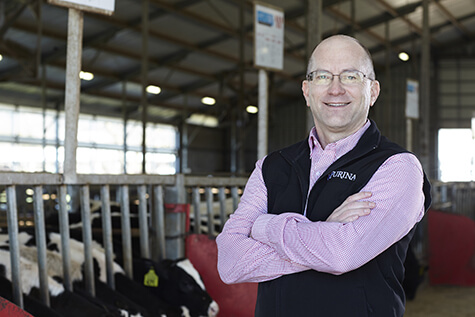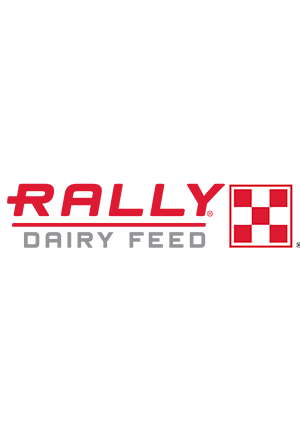
Three Tips to Improve Efficiency in Your Feed Ration
Cow : Management
The search for efficiency is a journey. When margins tighten, many dairy farmers take a magnifying glass to their herds to find cost-saving opportunities.
Focusing on efficiency can help your dairy cows reach key milestones more effectively and help you strike gold and attain, or exceed, your dairy milk production goals.
Let’s start digging! Here are a few areas to start exploring your herd efficiency.1. Start with income o
If efficiency is your end goal, then knowing your dairy feed costs can help you. Dairy feed cost per hundredweight (cwt) of milk is a key indicator of economic efficiency. Do you know the value of each additional pound of milk? That’s where income over feed cost comes into play.
By calculating income over feed cost, you can build a more cost-efficient dairy feed ration by estimating how much income you gain from a ration change.
Here’s an example:
Number of lactating cows: 625
Milk price: $16.44
Feed cost: $0.12 per pound of dry matter (DM)
Dry matter intake: 55 pounds
To calculate milk income: 51,875 pounds of milk shipped / 625 cows = 83 pounds per cow per day
83 pounds per cow per day x $16.44 per cwt / 100 = $13.65 per cow per day
To calculate feed costs: 55 pounds of DM per cow per day x $0.12 per pound of DM = $6.60 per cow per day
To calculate IOFC: $13.65 - $6.60 = $7.05 IOFC per cow per day
Including dairy milk production and current cost per hundredweight in the income over feed cost calculation gives you the return on investment for making a feed ration change. As market prices fluctuate, understanding the impact a feed ration change can have on your bottom line can help you make progress toward improved dairy feed cost efficiency.
Dry matter feed efficiency is more closely related to dry matter intake (DMI) and milk changes, as compared to income over feed cost. In fact, neither dairy feed costs nor milk price has any impact on dry matter feed efficiency. In general, however, as feed efficiency improves, it’s typical for income over feed cost to improve.
Some key factors that impact dry matter feed efficiency are:
So how do you do that? Dig into your data to compare dairy feed rations and production levels over time. Make sure to compare apples to apples. Benchmarks, like dry matter intake, likely are lower in summer compared to winter.
Both dairy feed costs and efficiency can be challenging to navigate, but good data can lead to great results for you and your dairy cows.
Learn more about how Purina partners with farmers across the country to do what’s best for their herds.
Focusing on efficiency can help your dairy cows reach key milestones more effectively and help you strike gold and attain, or exceed, your dairy milk production goals.
Let’s start digging! Here are a few areas to start exploring your herd efficiency.
1. Start with income o ver feed cost
ver feed cost
If efficiency is your end goal, then knowing your dairy feed costs can help you. Dairy feed cost per hundredweight (cwt) of milk is a key indicator of economic efficiency. Do you know the value of each additional pound of milk? That’s where income over feed cost comes into play.By calculating income over feed cost, you can build a more cost-efficient dairy feed ration by estimating how much income you gain from a ration change.
Here’s an example:
Number of lactating cows: 625
Milk price: $16.44
Feed cost: $0.12 per pound of dry matter (DM)
Dry matter intake: 55 pounds
To calculate milk income: 51,875 pounds of milk shipped / 625 cows = 83 pounds per cow per day
83 pounds per cow per day x $16.44 per cwt / 100 = $13.65 per cow per day
To calculate feed costs: 55 pounds of DM per cow per day x $0.12 per pound of DM = $6.60 per cow per day
To calculate IOFC: $13.65 - $6.60 = $7.05 IOFC per cow per day
Including dairy milk production and current cost per hundredweight in the income over feed cost calculation gives you the return on investment for making a feed ration change. As market prices fluctuate, understanding the impact a feed ration change can have on your bottom line can help you make progress toward improved dairy feed cost efficiency.
2. Dig deeper with feed efficiency
Looking at dry matter feed efficiency is another consideration. This benchmark helps you understand how efficiently your dairy cows convert feed into milk.Dry matter feed efficiency is more closely related to dry matter intake (DMI) and milk changes, as compared to income over feed cost. In fact, neither dairy feed costs nor milk price has any impact on dry matter feed efficiency. In general, however, as feed efficiency improves, it’s typical for income over feed cost to improve.
Some key factors that impact dry matter feed efficiency are:
- Breed
- Parity
- Days in milk
- Season
- Bodyweight changes
3. Strike gold with individual feed ration focus
Dry matter feed efficiency can be a valuable measurement for the entire herd or various groups. But each cow’s nutritional needs may not be the same as the cow eating next to her. It’s best to keep in mind individual cows’ needs and grouping strategies to help more cows reach peak feed efficiency. This is especially true for pre-peak animals and those in their last 100 days of lactation.So how do you do that? Dig into your data to compare dairy feed rations and production levels over time. Make sure to compare apples to apples. Benchmarks, like dry matter intake, likely are lower in summer compared to winter.
Both dairy feed costs and efficiency can be challenging to navigate, but good data can lead to great results for you and your dairy cows.
Learn more about how Purina partners with farmers across the country to do what’s best for their herds.



